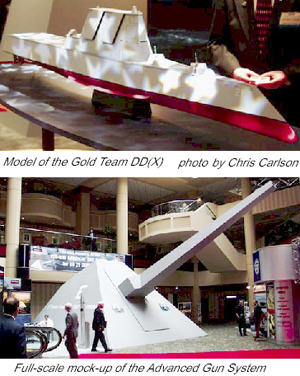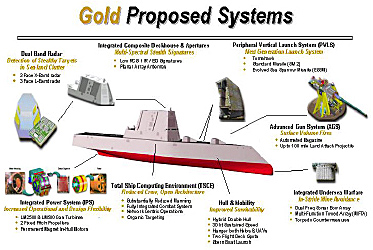 With the first ship of the class named (USS Zumwalt) and both Blue and Gold industry teams closing in on a final design, the Defense Department in November of 2001 suddenly canceled the DD-21 Land Attack destroyer.
With the first ship of the class named (USS Zumwalt) and both Blue and Gold industry teams closing in on a final design, the Defense Department in November of 2001 suddenly canceled the DD-21 Land Attack destroyer.
Pundits had called for its demise throughout the year. Loaded with new technology and stealthy, it was too large (10 - 14,000 tons), undercrewed (95), and too expensive, given its limited capability.
Fitted with an advanced 155mm gun system and VLS cells, its sensors and weapons were all oriented toward land attack and antiair warfare in a littoral environment. Little attention was given to antisurface or antisubmarine capability, since the US has overwhelming dominance in these areas -- right now.
The Navy, customer for the new ship, was silent about the cancellation. Support for the design had been lukewarm in the fleet, with only a few Pentagon admirals championing the concept. Plowing through the administrative gobbledygook filling the DoD announcement, their principal reason for the cancellation was that the single-mission design was too limiting and the ship was too big.
The Blue and Gold teams, led by General Dynamics and Northrop Grumman, started work on a new program for a family of warships. This program was created at the same time the DD-21 was killed.
 Of course, back in 1997, the DD-21 was also described as the first of a family of new combatants, and early articles discussed a CG-21, just as they now discuss a larger CG(X) that will follow the DD(X).
Of course, back in 1997, the DD-21 was also described as the first of a family of new combatants, and early articles discussed a CG-21, just as they now discuss a larger CG(X) that will follow the DD(X).
It should also be remembered that the DD-21 replaced another failed design concept: the Arsenal Ship. This “combatant” consisted of hundreds of VLS cells for Tomahawk missiles in a stealthy hull.
Bottom line: Industry tried to give the Navy what the Navy asked for. When the Navy saw what the design really looked like, they told industry to go back to square one. Five months later, in April 2002, the navy “downselected” the Northrop Grumman Design for the DD(X).
The new buzzword in the Pentagon this year is “transformational.” The military has to transform itself to meet new threats, so it has to be more “transformational.” The DD-21 wasn’t transformational enough, which in Navy terms means it didn’t incorporate enough new technology.
The DD(X) will be loaded with it, and to test out some of that gear, USS Arthur W. Radford will be used as a testbed. After she is decommissioned this summer, she will be gutted, with her superstructure and propulsion plant removed. She will then receive an electric propulsion plant, along with new radars and sonars. She will be manned by civilians and will be a testbed, not a combat unit. The refit will take about two years, and then the tests are expected to last until 2005. While the tests are performed, other aspects of the design will be worked on.
The current DD(X) concept includes a large helo deck aft (for UAVs as well as helicopters), a stern ramp for launching ship’s boats (stored internally to reduce radar signature?), special warfare craft, remote mine hunters, or USVs and UUVs. It has a wave-piercing bow, with a sustained speed “in excess of 30 knots.” It has a special double hull design for improved survivability, and an autonomous firefighting system.
The phased-array radars (including the SPY-3) will all be built into the superstructure, and may have an active jamming capability. The “multifunction” sonar suite will have a hull sonar and a towed array, and be capable of searching for submarines, mines, and may also be capable of torpedo defense. The VLS cells will line the deck edge, and it has two 155mm Advanced Gun systems forward. An Internet-like combat systems links all weapons, sensors, and ship’s equipment.
DD(X): Design That Lost (very slow: 361K).
BT
Back to The Naval Sitrep #22 Table of Contents
Back to Naval Sitrep List of Issues
Back to MagWeb Master Magazine List
© Copyright 2002 by Larry Bond and Clash of Arms.
This article appears in MagWeb (Magazine Web) on the Internet World Wide Web.
Other military history and related articles are available at http://www.magweb.com